TRIP
REPORTS: BIRDING THE WORLD
UGANDA July 2002: annotated trip
list
by Don Roberson
This is an annotated list of 392 native species that Rita Carratello and
I recorded in Uganda during 15 days in July 2002; see the
companion
trip report for more general details. Included in brackets are the
8 species Rita observed that I did not, plus two species (both long-tailed
cuckoos) that were heard well but not seen. As either of them would have
been a life bird for me, they are not counted on my life list but are noted
here since we heard them repeatedly. Some 90 other birds were seen as lifers
for me (** on list; 23% of total). The status given is that which we recorded,
and does not necessarily match the true status since we did not know vocalizations
well (although we did learn some during the trip, and our local guides
knew many others). More general comments have been added here and there
from research done after the trip, including a review of literature not
available at the time (e.g., Urban et al. 1998). After Uganda, Rita and
I continued on to northern Tanzania, and occasionally I comment about status
there. The list here includes only those birds personally seen by Rita
or me or, in a very few cases, birds heard with which I have prior experience
in Africa.
The abbreviation "QEII" means Queen Elizabeth II National Park; "NP"
or "park" means National Park. Points or directions of the compass are
often abbreviation (e.g., "SE of Masindi" = southeast of Masindi); "L."
means Lake.
BIRDS
Little Grebe Tachybaptus ruficollis: a half-dozen in the pond
outside the Lakeview Pavilion Hotel, Mbarara
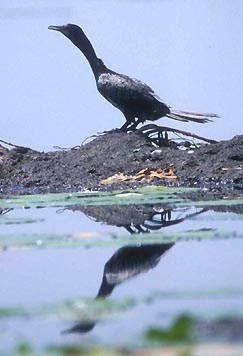 Pink-backed
Pelican Pelecanus rufescens: recorded widely; good numbers at Murchison
and along Lake Victoria
Pink-backed
Pelican Pelecanus rufescens: recorded widely; good numbers at Murchison
and along Lake Victoria
White-breasted Cormorant Phalacrocorax lucidus: lots in Kaziranga
Channel, QEII, and Lake Victoria at Jinja; some (e.g., Stevenson &
Fanshawe 2002) consider this a subspecies of Great Cormorant P. carbo
Long-tailed Cormorant Phalacrocorax africanus: several on Lake
Bisina (photo right) and at Lake Victoria
at Jinja
African Darter Anhinga rufa: about a dozen along the Victoria
Nile below Murchison Falls
Little Bittern Ixobrychus minutus: one in reeds fronting the
Kaziranga Channel in QEII park
Gray Heron Ardea cinerea: widespread at Lake Mburo, QEII park,
and Murchison Falls
Black-headed Heron Ardea melanocephala: the really common heron,
most everywhere including forest pools
Goliath Heron Ardea goliath: one or two daily at QEII; half-dozen
at Murchison park, three on L. Bisina
Purple Heron Ardea purpurea: a couple per day in Murchison park
and at L. Bisina
Great Egret Ardea alba: widespread at Lake Mburo, QEII park,
and in Murchison Falls park
Intermediate Egret Egretta intermedia: we didn't spend a lot
of time on egrets; recorded at Lake Mburo, QEII park, and Murchison Falls
Little Egret Egretta garzetta: not a lot; a few along Lake Mburo,
QEII park, and at Murchison Falls
Squacco Heron Ardeola ralloides: one in Kaaku Swamp and a dozen
on Lake Bisina
Rufous-bellied Heron Ardeola rufiventris **: one in Kaaku Swamp
and another at the edge of Lake Mburo were highlights
Cattle Egret Bubulcus ibis: widespread; recorded daily when
away from the mountains
Striated Heron Butorides striatus: fair numbers daily at Lake
Mburo and in QEII park
Hamerkop Scopus umbretta: a few daily in QEII and Murchison
parks, and on Lake Bisina
Yellow-billed Stork Mycteria ibis: a few scattered storks around
QEII park and vicinity
African Openbill Anastomus lamelligerus: a couple in Kaaku Swamp,
and scattered birds QEII, Kibale, L. Bisina
Saddle-billed Stork Ephippiorhynchus senegalensis: an adult
and immature at edge of papyrus on the Nile, Murchison
Marabou Stork Leptoptilos crumeniferus: common and widespread
in lowlands, especially around Lake Victoria
Shoebill Balaeniceps rex **: wonderful views of an obliging
adult at the Victoria Nile delta, Murchison Falls park; details on my Shoebill
family page
Sacred Ibis Threskiornis aethiopicus: two at Murchison Falls
park were it
Hadada Ibis Bostrychia hagedash: common and widespread, including
some along river at Buhoma, Bwindi
Fulvous Whistling-Duck Dendrocygna bicolor: a flock of 6 in
Kaaku Swamp was a surprise; a scarce bird in Uganda
White-faced Whistling-Duck Dendrocygna viduata: flock of 5 in
Kaaku Swamp, and 40+ in Murchison Falls park
Egyptian Goose Alopochen aegyptiacus: Lots in QEII park but
only a couple seen in Murchison Falls park
Spur-winged Goose Plectropterus gambensis: a pair in Kaaku Swamp
were the only ones
African Pygmy-goose Nettapus auritus: about 4 pairs on Lake
Bisina that we approached in our canoe
Osprey Pandion haliaetus: one in Murchison Falls park
Bat Hawk Macheiramphus alcinus: great views on one chasing bats
at the top of Murchison Falls before dusk
Black Kite Milvus migrans: the resident race parasiticus
(Yellow-billed Kite) was widespread around towns and cities
Black-shouldered Kite Elanus caeruleus: 8 birds in 6 scattered
days in lowland open country
African Fish-Eagle Haliaeetus vocifer: common & widespread
on lakes and rivers, including a dozen nests and 40 birds around Lake Mburo
on our boat ride. We shared our boat that day with fish-eagle researchers
looking for nests to climb to get blood samples from young.
Palm-nut Vulture Gypohierax angolensis: a couple at Entebbe,
more in Murchison Falls park
Hooded Vulture Necrosyrtes monachus: a few daily in open country
east of Jinja, often near towns
White-backed Vulture Gyps africanus: just a couple in QEII park
White-headed Vulture Trigonoceps occipitalis: one in Murchison
Falls park
Brown Snake-Eagle Circaetus cinereus: one at QEII park, and
a couple daily in Murchison Falls area
Western Banded Snake-Eagle Circaetus cinerascens **: this beautiful
small raptor was perched in an overgrown orchard SE of Masindi for great
views
African Marsh-Harrier Circus ranivorus: singles at Kaaku Swamp,
Lake Mburo, and Lake Bisina
African Harrier-Hawk Polyboroides typus: common along the Nile
at Murchison, more enroute to Entebbe
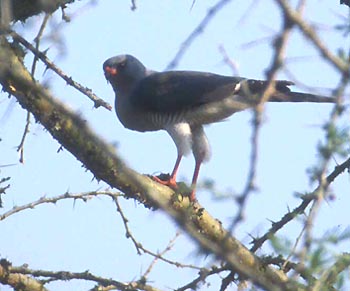 Dark
Chanting-Goshawk Melierax metabates: a couple hunting the open plains
N of the Nile at Murchison
Dark
Chanting-Goshawk Melierax metabates: a couple hunting the open plains
N of the Nile at Murchison
Gabar Goshawk Micronisus gabar: one was eating a small bird
it had caught at L. Mburo (photo right)
Lizard Buzzard Kaupifalco monogrammicus: a couple near L. Victoria,
both W & E of Entebbe
Shikra Accipiter badius: a few birds in the Entebbe-Jinja vicinity
African Goshawk Accipiter tachiro: an imm. was in open country
outside Bwindi; 2 were near Masindi
Great Sparrowhawk Accipiter melanoleucus: a large accipiter
in flight over Ruhiza was surely this species
Mountain Buzzard Buteo oreophilus: a pair was doing courtship
flights over Ruhiza
Tawny Eagle Aquila rapax: an imm. at L. Mburo was it
Wahlberg's Eagle Aquila wahlbergi: one in flight with other
raptors on thermals over Butiába Escarpment
African Hawk-Eagle Hieraaetus spilogaster: one soaring on thermals
over Butiába Escarpment
Ayres's Hawk Eagle Hieraaetus ayresii **: a pair were interacting
over Mubwindi Swamp, Ruhiza
Bateleur Terathopius ecaudatus: one or two daily in the L. Mburo,
QEII, and Murchison parks plains
Long-crested Eagle Lophaetus occipitalis: common in open country
throughout, esp. the south
Grey Kestrel Falco ardosiaceus: a few in open grasslands N of
Nile, Murchison Falls NP
Crested Francolin Francolinus sephaena: fairly common at L.
Mburo, more so at Murchison Falls NP
Heuglin's Francolin Francolinus icterorhynchus **: one watched
at close range in grasslands N of Nile, Murchison
Scaly Francolin Francolinus squamatus: noisy pair eventually
seen very well in Mabira Forest
Handsome Francolin Francolinus nobilis **: this large gray &
chestnut francolin, an Albertine Rift endemic, was accidentally flushed
by our guard in Mubwindi Swamp, Ruhiza
Red-necked Spurfowl Francolinus afer **: very common at L. Mburo
and QEII parks
Helmeted Guineafowl Numida meleagris: common in L. Mburo, QEII,
and Murchison Falls parks
Crested Guineafowl Guttera pucherani: small party seen crossing
road in Kibale Forest
Small Buttonquail Turnix sylvatica **: two on the dirt track
through wide grasslands, QEII park
African Finfoot Podica senegalensis**: the highlight of our
Lake Mburo visit was one swimming and perched at lake’s edge during our
boat trip
White-spotted Flufftail Sarothrura pulchra **: a pair seen very
well inside Mabira Forest; this was a real treat since previous efforts
to tape them in at Bigodi Swamp left us frustrated. These were seen without
any tapes as our guide Ibraham heard them scuttling in the undergrowth
and we were able to see them well
African Black Crake Amaurornis flavirostris: rather common at
Kaaku Swamp (inc. precocial young), L. Mburo, QEII and Murchison parks,
all at water’s edge
Purple Swamphen Porphyrio porphyrio: one at Kaaku Swamp
Common Moorhen Gallinula chloropus: two at Kaaku Swamp
African Jaçana Actophilornis africana: a few on lily
pads at Lake Bisina; see next species
Lesser Jaçana Microparra capensis **: a major treat from
the canoe ride on Lake Bisina were a few nicely seen Lesser Jacanas --
even got close enough for a distant but identifiable photo! These are tiny
compared to African Jaçana
Grey Crowned Crane Balearica regulorum: the national bird of
Uganda was seen in pairs or family groups at Kaaku Swamp, and QEII and
Murchison Falls NP
Black-bellied Bustard Eupodotis melanogaster **: one male flushed
at our vehicle’s approach in L. Mburo NP; it was basically seen only in
flight but Hartlaub’s E. hartlaubii does not occur anywhere near
here
Water Thick-knee Burhinus vermiculatus: pairs were found in
grasslands with scattered mudpuddles at L. Mburo, on the boat ride in QEII
park, and also along the Nile at Murchison Falls NP
Senegal Thick-knee Burhinus senegalensis **: a pair was finally
identified confidently from the boat up the Nile to Murchison Falls after
several false alarms caused by the preceding species
Rock Pratincole Glareola nuchalis: common on rocky islets in
the Nile just above and just below Murchison Falls
Spur-winged Lapwing Vanellus spinosus: a few in Kaaku Swamp;
common in QEII & Murchison parks
Long-toed Lapwing Vanellus crassirostris: a few pairs Kaaku
Swamp, L. Mburo, L. Bisina; also Murchison
Wattled Lapwing Vanellus senegallus: widespread in open country
or grasslands, L. Mburo to Murchison
Crowned Lapwing Vanellus coronatus: four in a burned area outside
L. Mburo
Black-headed Lapwing Vanellus tectus: two pair (photo
below, lefthand pair) in grasslands N of Nile in Murchison Falls
NP
Senegal Lapwing Vanellus lugubri: one with the Brown-chested
Lapwings outside L. Mburo NP
Brown-chested Lapwing Vanellus supercilosus **: this is a prized
specialty of L. Mburo NP or, more accurately, seasonally in short-grass
fields just outside the park. We had searched several “regular” spots without
success when Hassan talked to a local cattle-herder. Most surprisingly,
he knew they had moved to a new spot -- recently burned. So we back-tracked
and walked out, following his directions, which were spot on. We saw 13
birds very nicely in loose mixed groups with Wattled Lapwing. All were
rather skittish but I got distant shots (photo
above, righthand)
Kittlitz's Plover Charadrius pecuarius: common along Kazinga
Channel, QEII park
Three-banded Plover Charadrius tricollaris: one from boat on
Kazinga Channel, QEII park
Common Sandpiper Tringa hypoleucos: four from boat Kazinga Channel,
QEII park, another on Nile at Murchison; these were presumably early fall
migrants (all were adults)
Gray-headed Gull Larus cirrocephalus: more than a dozen non-breeding
summerers were at a roost on Kazinga Channel
Whiskered Tern Chlidonias hybridus: a few foraging over Lake
Bisina: perhaps these are summering terns; they were either in basic plumage
or in partial alternate plumages
African Green-Pigeon Treron calva: a few seen perched enroute
to Kampala, in mixed small flocks with the next species
Bruce's Green-Pigeon Treron waalia **: we were surprised to
see a couple small flocks in thornscrub woodland SE of Masindi, enroute
to Kampala
Rock Dove Columba livia: common in Kampala and other large cities;
this non-native bird not included in totals
Emerald-spotted Wood-Dove Turtur chalcospilos: the widespread
and common wood-dove of open country and thorn-scrub
Blue-spotted Wood-Dove Turtur afer: the common wood-dove of
thick forests, such as Bwindi & Kibale
Tambourine Dove Turtur tympanistria: a few in thick undergrowth
most days, from Rwenzoris to Murchison & Mabira
Ring-necked Dove Streptopelia capicola: common at lower elevations,
including through Murchison Falls NP
Red-eyed Dove Streptopelia semitorquata: “I am a Red-eyed Dove”
is an exceptionally common vocalization heard everywhere, from woodland
to thornscrub, except at lower elevations where Ring-necked Doves take
over
Mourning Collared-Dove Streptopelia decipiens: rather common
in Murchison Falls NP, but seen nowhere else
Vinaceous Dove Streptopelia vinacea **: reasonably common along
the Nile edges at Murchison Falls NP, but it took awhile looking for them
to find them among the Ring-neckeds and Mournings
Laughing Dove Streptopelia senegalensis: widespread in QEII
& Murchison parks, and more elsewhere
Brown (Meyer's) Parrot Poicephalus meyeri **: small groups in
L. Mburo NP and SE of Masindi in scrub
Red-headed Lovebird Agapornis pullarius **: two seen only in
flight from our vehicle near Jinja; they looked all-green in flight, and
i.d. is based on range
Great Blue Turaco Corythaeola cristata: common in the climax
forest, including Bwindi (all elevations), Kibale, Bigodi Swamp (advertised
as the “home of the Great Blue Turaco”), and Mabira Forest
Ross's Turaco Musophaga rossae: a half-dozen were very shy and
seen only in flight at L. Mburo NP; Rita missed them, alas
White-crested Turaco Turaco leucolophus **: I very much like
turacos, and really hoped to see this one, but time was running out on
our chances when Hassan saw a couple fly over the road in thornscrub SE
of Masindi, on the fast road to Entebbe. It took some time to find a spot
to turn around and get back to the spot, and about 20 minutes more of searching
to relocate them, but then it was all worth it. It was an adult feeding
a fledged youngster, and we had wonderful views
Black-billed Turaco Turaco schuettii: Heard daily in the forests
of the Rwenzoris, and also heard in Kibale and Mabira forests, but the
only ones seen were taped in by Alfred along the high ridge enroute back
from Mubwindi Swamp
Bare-faced Go-away-bird Corythaixoides personatus **: reasonably
common in L. Mburo NP; the only other was seen at the Butiába Escarpment
Eastern Grey Plantain-eater Crinifer zonurus: only a couple
our first week (Entebbe, Mburo) but then several each day during our last
week from Murchison to L. Victoria
Pied (Jacobin) Cuckoo Clamator jacobinus: one in agricultural
fields and scrub outside Buhoma town
Red-chested Cuckoo Cuculus solitarius: Singles nicely viewed
at Buhoma, Kibale, and Mabira forests; others heard
Black Cuckoo Cuculus clamosus: a vigorously singing male was
watched during our Gorilla hike at Buhoma; others were heard in Bwindi
park
[Barred Long-tailed Cuckoo Cercococcyx montanus: one was calling
close to our hut at Ruhiza, but was not responsive so went unseen; would
have been a lifer]
Dusky Long-tailed Cuckoo Cercococcyx mechowi **: we heard a
fair number on our Gorilla hike, and more inside the forest at Buhoma the
next day; we had one respond to the tape of its own voice and, after a
lot of work, we finally got excellent views
[Olive Long-tailed Cuckoo Cercococcyx olivinus: several heard
inside the forest at Buhoma, but refused to come in to the tape so none
was seen; would have been a lifer]
Klaas's Cuckoo Chrysococcyx klaas: two seen in Murchison Falls
park; heard at Mabira Forest
African Emerald Cuckoo Chrysococcyx cupreus: the “hello Judy!”
song was a dominant sound in the forest at Bwindi and Kibale, but we never
made much effort to see one and, consequently, never did
Dideric Cuckoo Chrysococcyx caprius: one nicely seen at our
Buhoma lodging
Yellowbill Ceuthmochares aereus: lots inside Kibale forest,
and several seen well; more at Mabira Forest
White-browed Coucal Centropus superciliosus: this open scrubland
coucal seen daily in QEII and Murchison parks, and during long drives through
suitable habitat in between
Blue-headed Coucal Centropus monachus: a swamp coucal seen in
papyrus at L. Mburo; heard at Murchison
Senegal Coucal Centropus senegalensis: a couple in thornscrub
E of Masindi
African Wood-Owl Strix woodfordii: we taped one in at Ruhiza
after dinner; excellent views with floodlight
Spotted Eagle-Owl Bubo africanus: a dark-eyed owl found at a
day roost north of the Nile in Murchison Falls NP; this is the taxa cinarescens,
considered by some (e.g., Handbook of Birds of the World) to be
a separate species (Grayish Eagle-Owl) from the yellow-eyed Spotted Eagle-Owl
occurring south of the Equator
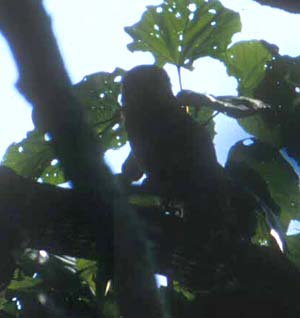 Pel's
Fishing-Owl Scotopelia peli **: another major highlight for me was
seeing this often-sought fish owl. Hassan knew woods below Murchison Falls
where day roosts are sometimes found. Our boat trip up the Albert Nile
to the falls landed us on a steep trail to the top of the falls. If one
went the other way -- steeply down into a riverine canyon, one got to the
possible roost spot. Rita waited behind while the British group and I followed
Hassan down into those woods and, remarkably, Hassan found a roosting owl.
Alas, it flushed rather rapidly -- before everyone got on it -- but I did
manage to get one photo off (photo right)
Pel's
Fishing-Owl Scotopelia peli **: another major highlight for me was
seeing this often-sought fish owl. Hassan knew woods below Murchison Falls
where day roosts are sometimes found. Our boat trip up the Albert Nile
to the falls landed us on a steep trail to the top of the falls. If one
went the other way -- steeply down into a riverine canyon, one got to the
possible roost spot. Rita waited behind while the British group and I followed
Hassan down into those woods and, remarkably, Hassan found a roosting owl.
Alas, it flushed rather rapidly -- before everyone got on it -- but I did
manage to get one photo off (photo right)
Rwenzori Nightjar Caprimulgus ruwenzorii **: Now split from
Montane Nightjar C. poliocephalus (e.g., Holyoak 2001), this is
nearly an Albertine Rift endemic. We heard several after dinner at Ruhiza
with Alfred and Hassan, but none came to the tape. Rita and I both woke
up very early the next morning (jet lag) and so we took our flashlights
down through the adjacent village to an overlook where we heard a couple
more. I tried to whistle the close one in, but it didn’t immediately respond.
At dawn’s first blush, that bird got up and flew directly over us several
times for acceptable views. The voice is a quavered two-note song, imitatible,
and it apparently gives it from the scrub and bracken below the ridge lines
Swamp Nightjar Caprimulgus natalensis: a couple flushed from
the road during our drive back to the lodge from the top of Murchison Falls
Black-shouldered Nightjar Caprimulgus nigriscapularis **: a
nightjar began singing repeatedly in the middle of the night outside our
tent at L. Mburo NP; the whistle-and-quavering trill recalled Rwenzori
Nightjar but they don’t occur down in thornscrub. It was a warm night so
I got up in just my T-shirt and shoes and stalked it with a flashlight;
I found it calling from a bare broken limb nearby between bouts of foraging
flights. My flashlight wasn’t that great for seeing details, so the i.d.
is primarily on voice. Swamp Nightjar is also said to be common here, but
its voice (monotonous “chop..chop..chop”) is very different. It was good
to see this species again, since we thought we had it in Gabon but research
by others later proved those birds to be Fiery-necked Nightjar C. pectoralis
(see Gabon trip list)
Slender-tailed Nightjar Caprimulgus clarus: one seen at dawn
during a game drive at QEII park
Pennant-winged Nightjar Macrodipteryx vexillarius **: another
fabulous highlight were these incredible nightjars flushed from the road
on our after-dark drive back from the top of Murchison Falls. In all we
saw 15 males and 2 females; for a couple males we stopped before they flushed
off the road and had binocular views. Others flushed as we approached but
the long wing pennants flashed white in the headlights. We had found a
male dead on the road into Murchison park the day before, and we’ve kept
the pennant as a souvenir...
Little Swift Apus affinis: Scattered flocks of swift -- from
the Rwenzoris to Mabira Forest -- usually had this species; the largest
group was 100+ over the Kazinga Channel
White-rumped Swift Apus caffer: a flock of 50+ was swirling
over us at dusk at L. Mburo; scattered others were elsewhere from QEII
to Butiába Escarpment
Mottled Swift Tachymarptis aequatorialis: a very large all-dark-brown
swift with Scarce Swifts near Ruhiza was thought by me to be this species,
although no one else got on it. Alfred saw Alpine Swift T. melba
in the same big flock, but I missed it (would have been a lifer)
Scarce Swift Schoutedenapus myoptilus **: a large fast-moving
flock of 50+ were over open country below Ruhiza; we got decent views of
these but less than adequate looks at other swifts in the flock
African Palm-Swift Cypsiurus parvus: widespread in lowlands
from QEII and Murchison parks to L. Bisina
Speckled Mousebird Colius striatus: the common and widespread
mousebird, one of the most often encountered birds on the trip. We recorded
it every day, and had 50+ most days
Blue-naped Mousebird Urocolius macrourus: small parties at L.
Mburo, QEII and Murchison parks
Narina Trogon Apaloderma narina: one perched female on the hike
to Mubwindi Swamp
Bar-tailed Trogon Apaloderma vittatum: fine views of a perched
bird below Ruhiza; more heard in Kibale Forest
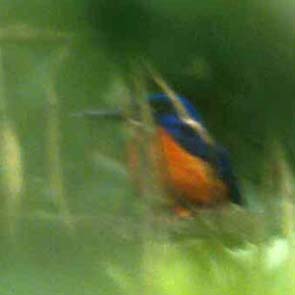 Shining
Blue Kingfisher Alcedo quadribrachys: Alfred spotted one just over
the small stream on our first afternoon at Buhoma; it flew deep into the
tangles but (amazingly) I was able to shoot a photo (photo
right) by lying on the ground, using a log as a tripod, and
shooting 400 speed film at 1/8 second! This was an unexpected treat since
it is a shy and elusive species
Shining
Blue Kingfisher Alcedo quadribrachys: Alfred spotted one just over
the small stream on our first afternoon at Buhoma; it flew deep into the
tangles but (amazingly) I was able to shoot a photo (photo
right) by lying on the ground, using a log as a tripod, and
shooting 400 speed film at 1/8 second! This was an unexpected treat since
it is a shy and elusive species
Pied Kingfisher Ceryle rudis: common around lakes and channels:
L. Victoria, L. Mburo, QEII etc.
Striped Kingfisher Halcyon chelicuti: we saw at least 5 during
a dawn drive in thornscrub at L. Mburo park but as the sun came up they
seemed to melt away; we saw only a few singles up by Murchison thereafter
Gray-headed Kingfisher Halcyon leucocephala: small numbers of
this chesnut-bellied open country kingfisher were in QEII and Murchison
parks
Giant Kingfisher Megaceryle maxima: one along the Nile at Murchison
Falls NP
Woodland Kingfisher Halcyon senegalensis: fairly common in denser
woodland than Gray-headed: L. Mburo to Murchison, Bisina, and Mabira
Malachite Kingfisher Alcedo cristata: regular near lakes and
streams: L. Mburo, QEII, Murchison etc.
African Pygmy-Kingfisher Ispidina picta: tiny and hard to spot,
but pairs or small groups at several spots in QEII park -- including in
the shrubs next to the outdoor dining room -- and outside Kibale Forest
Little Bee-eater Merops pusillus: common in the open-country
parks: QEII and Murchison
Cinnamon-chested Bee-eater Merops oreobates: the highland bee-eater,
common at Ruhiza
Blue-breasted Bee-eater Merops variegatus: a half-dozen at papyrus
edge at the Nile Delta, Murchison park
White-throated Bee-eater Merops albicollis: a couple in scrub
country E of Masindi
Swallow-tailed Bee-eater Merops hirundineus **: four of these
small, elegant bee-eaters were hunting the plains N of the Nile in Murchison
Falls park
Black Bee-eater Merops gularis: a beautiful example was perched
on dead tree top inside forest at Buhoma
Madagascar Bee-eater Merops superciliosus: one of these southern
migrants was carefully identified from our boat on the Kazinga Channel;
we were to have more in nw. Tanzania, so this must be prime time
Red-throated Bee-eater Merops bulocki **: common (40+) along
the Albert Nile during the boat ride up to Murchison Falls
Northern Carmine Bee-eater Merops nubicus: more than a half-dozen
in the plains N of Nile, Murchison park
Broad-billed Roller Eurystomus glaucurus: common in open thornscrub
from L. Mburo to Murchison and vicinity. [Rita had an unidentified roller
in Murchison park, perhaps Abyssinian Roller Coracias abyssinicus,
but we couldn’t refind it.]
Green Woodhoopoe Phoeniculus purpureus: we had a loose flock
of 11 in L. Mburo park, and another 8 in thorn-scrub E of Masindi
White-headed Woodhoopoe Phoeniculus bollei: small parties, perhaps
8 in all, in the mossy forest at Mubwindi Swamp, Ruhiza
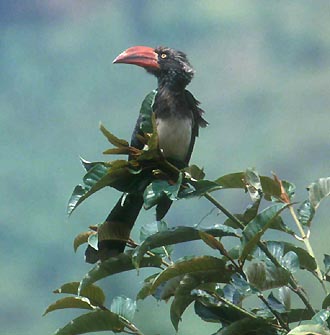 African
Hoopoe Upupa africana: just one or two seen from the moving vehicle
in Murchison park
African
Hoopoe Upupa africana: just one or two seen from the moving vehicle
in Murchison park
Abyssinian Ground-Hornbill Bucorvus abyssinicus: family parties
(2 ad., 1 imm.) in grasslands N of Nile in Murchison Falls park, and also
south of the park in forest enroute to Masindi. The latter flushed from
road into trees
African Grey Hornbill Tockus nasutus: a couple at L. Mburo,
and then daily in Murchison vicinity
Crowned Hornbill Tockus alboterminatus: singles at Entebbe,
Ruhiza (photo right), and roadsides
N of Masindi
Black-and-white-casqued Hornbill Ceratogymna subcylindricus:
a half-dozen of these big bruisers were perched in the small woodlot next
to our Entebbe tea-garden; common in the Rwenzori Mts., and Kibale &
Mabira Forests, and a few elsewhere. They are impressive
Yellow-rumped Tinkerbird Pogoniulus bilineatus: the easily-identified
calls alerted us to the fact this little bird was around almost daily anywhere
in woodland, but rather few actually seen. One was working the fruiting
tree just outside our room at Buhoma for multiple viewing ops
Yellow-throated Tinkerbird Pogoniulus subsulphureus: more of
an interior forest tinkerbird, heard at Buhoma and several seen inside
Kibale & Mabira Forests
Speckled Tinkerbird Pogoniulus scolopaceus: one inside the forest
at Buhoma, Bwindi, in a mixed flock
Gray-throated Barbet Gymnobucco bonapartei: several seen daily,
and more heard, in forests at Bwindi, Kibale, and Mabira
Spot-flanked Barbet Tricholaema lacrymosa: a thornscrub barbet
seen at L. Mburo and Murchison parks
Hairy-breasted Barbet Tricholaema hirsuta **: an adult watched
feeding a youngster in a big fruiting fig tree at headquarters, Kibale
Forest
Yellow-spotted Barbet Buccanodon duchaillui: a couple glimpsed,
more heard, inside forests at Buhoma and Mabira
Black-billed Barbet Lybius guifsobalito: one in the scrub N
of Nile, Murchison Falls park
Double-toothed Barbet Lybius bidentatus: this colorful barbet
appeared at the most unlikely places: in a small garden at a agricultural
school in sw. Uganda where Hassan stopped to buy fruit, and at random roadside
stops to and from Murchison park. None was found in any reserve or park
Yellow-billed Barbet Trachyphonus purpuratus: heard in Kibale
& Mabira Forests, glimpsed at Ruhiza. A big canopy barbet of thick
jungle
Lesser Honeyguide Indicator minor: singles in Kibale Forest
and scrub SE of Masindi
Dwarf Honeyguide Indicator pumilio **: two down in Mubwindi
Swamp were seen by Alfred playing the tape of Western Green Tinkerbird
Pogoniulus
coryphaeus, which these honeyguides parasitize. Once they came in,
they were very tame and inquisitive; this was a cool highlight for me.
Another was at “The Neck” during our drive to Buhoma
Cassin's Honeybird Prodotiscus insignis: one in Kibale Forest
Brown-eared Woodpecker Campethera caroli: one nicely viewed
inside Kibale Forest
Nubian Woodpecker Campethera nubica: singles in thornscrub
outside L. Mburo and SE of Masindi
Cardinal Woodpecker Dendropicos fuscescens: scattered individuals
from Ruhiza to QEII to E of Masindi
Elliot's Woodpecker Dendropicos elliotii **: one working a big
tree-trunk inside the forest at Buhoma
Flappet Lark Mirafra rufocinnamomea: common in the grasslands
of QEII and Murchison parks
Plain Martin Riparia paludicola: single birds overhead in a
couple open places in the Rwenzoris
Banded Martin Neophedina cincta: one overhead in QEII park
Mosque Swallow Hirundo senegalensis: rather common in L. Mburo
park; didn’t really look at swallows much after that — there may have been
Red-rumped H. daurica and Rufous-chested H. semirufa about,
but didn’t take the time to sort them out as we’d seen all of them widely
before
Lesser Striped Swallow Hirundo abyssinica: scattered birds on
most days in open country in w. Uganda
Barn Swallow Hirundo rustica: a few over Mweya Lodge were either
summering or early migrants
Angola Swallow Hirundo angolensis: very common in towns in s.
& sw. Uganda, but not in the north
Wire-tailed Swallow Hirundo smithii: several along the Nile
at Murchison Falls park
Black Sawwing Psalidoprocne pristoptera: common & widespread
in w. & s. Uganda; seen daily
White-headed Sawwing Psalidoprocne albiceps: a few daily in
QEII and Murchison Falls parks
Yellow-billed Shrike Corvinella corvina **: a dozen moving through
thornscrub east of Masindi was an unexpected treat — and a lifer for Hassan
Common Fiscal Lanius collaris: common and widespread in open
country
Gray-backed Fiscal Lanius excubitoroides: very common in open
country, such as L. Mburo, QEII, and Murchison parks
Mackinnon's Shrike Lanius mackinnoni: common at forest edge
in Bwindi, at all elevations
Tropical Boubou Laniarius aethiopicus: one in scrub east of
Masindi [and more in Tanzania later]
Luehder's Bushshrike Laniarius luehderi: Alfred taped in one
below Ruhiza that then stayed around at eye-level for photos!
Black-headed Gonolek Laniarius erythrogaster **: brilliantly
red below, but surprising hard to spot, we ended up seeing a fair number
from L. Mburo to QEII to Murchison parks
Papyrus Gonolek Laniarius mufumbiri **: what a fine bird! a
trio or more were bubbling away in papyrus at Kazinga Channel and called
out for great views (and photos! see
intro page); others were seen in Bigodi Swamp and various other papyrus
swamps north of Ft. Portal. Just beautiful and personable
[Mountain (Fuelleborn’s) Boubou Laniarius (poensis) fuelleborni:
Rita saw one inside the forest at Ruhiza with Hassan; I missed it. The
all-black boubou here is now often split from L. poensis. Sooty
Boubou L. leucorhynchus was heard at Mabira Forest, but we couldn’t
see this potential lifer ]
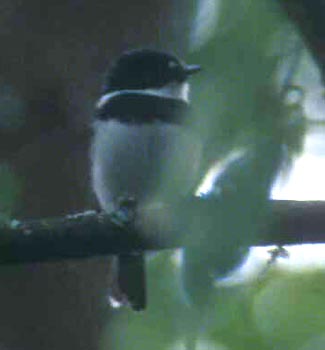 Brubru
Nilaus afer: one is scrub east of Masindi, with a foraging flock
Brubru
Nilaus afer: one is scrub east of Masindi, with a foraging flock
Northern Puffback Dryoscopus gambensis **: One at Entebbe and
a couple more below Ruhiza in roadside woodland edge
Black-crowned Tchagra Tchagra senegala: several during the game
drive in Murchison Fall NP
Brown-crowned Tchagra Tchagra australis: fairly common in scrub
throughout, from open fields at Ruhiza to Ft. Portal area to Murchison
Gray-green (Bocage's) Bushshrike Telophorus bocagei: a single
bird greeted us in front of our lodgings at Buhoma — at the forest edge
there
Doherty's Bushshrike Malachonotus dohertyi **: Alfred brought
one in (for photos! see
intro page) with his tape below Ruhiza
Chinspot Batis Batis molitor: rather common at lower elevations
in Bwindi (The Neck, Buhoma)
Rwenzori Batis Batis diops **: I saw at least four (photo
right) on the hike to Mubwindi Swamp, Ruhiza; a very nice Albertine
Rift endemic (sexes are alike) at upper elevations
Brown-throated Wattle-eye Platysteira cyanea: always a treat
to see or hear, we had widely scattered birds from Entebbe to Buhoma (including
outside our room) to Kibale Forest
Chestnut Wattle-eye Platysteira castanea: another fine small
bird, seen inside forests at Buhoma (female) and Mabira (male)
Fork-tailed Drongo Dicrurus adsimilis: widespread and common
in open woods (e.g., Mburo, QEII, Murchison)
Velvet-mantled Drongo Dicrurus modestus: a few up at Ruhiza,
and another in Mabira Forest
Piapiac Ptilostomus afer **: common in Murchison Falls park,
often with game, and around Jinja
Pied Crow Corvus albus : very common in open country, esp. QEII
park and around Kampala
African Black-headed Oriole Oriolus larvatus: singles at Entebbe
and in scrub east of Masindi
Montane Oriole Oriolus percivali: rather common in forests at
Ruhiza, and heard at Buhoma
Black-and-white Shrike-Flycatcher Bias musicus: this very dapper
bird was seen in the forests at Buhoma and Kibale
African Paradise-Flycatcher Terpsiphone viridis: a scattered
bird here and there, Ruhiza to Masindi
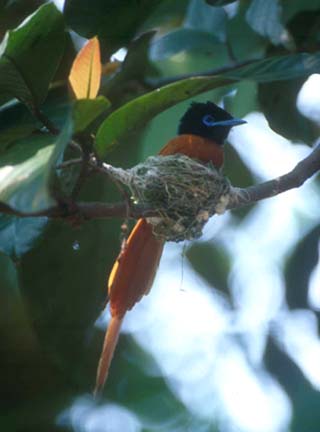 Rufous-bellied
(Black-headed) Paradise-Flycatcher Terpsiphone rufiventer **: a pair
was photographed nest-building at the Kibale Forest headquarters (photo
right) ; another was in Mabira Forest
Rufous-bellied
(Black-headed) Paradise-Flycatcher Terpsiphone rufiventer **: a pair
was photographed nest-building at the Kibale Forest headquarters (photo
right) ; another was in Mabira Forest
White-bellied Crested-Flycatcher Elminia albiventris **: one
in Mubwindi Swamp, Ruhiza
African Blue-Flycatcher Elminia longicauda: a few were seen
in Kibale Forest
White-tailed Blue-Flycatcher Elminia albicauda **: constantly-moving
birds were in the canopy of roadside trees at Ruhiza & Buhoma, acting
like Painted Redstarts
Black Cuckoo-shrike Campephaga flava: a female studied at length
at Buhoma
Red-shouldered Cuckoo-shrike Campephaga phoenicea: male &
female in scrub se. of Masindi
Petit's Cuckoo-shrike Campephaga petiti: two males + imm. male
at Buhoma
Gray Cuckoo-shrike Coracina caesia: rather common in highland
forest at Ruhiza
Common Bulbul Pycnonotus barbatus: common & widespread everywhere
Shelley's Greenbul Andropadus masukuensis: one seen with Alfred
on hike to Mubwindi Swamp, Ruhiza
Little Greenbul Andropadus virens: common and widespread at
forest edge, and seen quite a number of times at Buhoma, Kibale and Mabira
forests. It sings all day long — even the hot midday — so its song is the
“background” to many Uganda scenes
Slender-billed Greenbul Andropadus gracilirostris: one each
seen nicely at Ruhiza, “The Neck,” and Buhoma, and two of them photo’d.
A canopy species
Yellow-whiskered Greenbul Andropadus latirostris: heard commonly
at Buhoma, eventually seen in Mabira Forest
Eastern Mountain Greenbul Andropadus nigriceps: reasonably common
at Ruhiza; now split from A. tephrolaemus of west Africa
Yellow-throated Greenbul Chlorocichla flavicollis: a big rangy
greenbul of big trees in open country or edge, seen at Buhoma. The locals
all call it “Leaflove” but that name reserved for a bird we did not see
[Joyful Greenbul Chlorocichla laetissima: Rita saw one with
Ronald inside Kibale Forest while I was photographing something else. I’ve
seen it in Kakamega Forest, Kenya ]
Cabanis's Greenbul Phyllastrephus cabanisi: Alfred taped one
in for us below Ruhiza; this is a different taxa than the birds I saw east
of the Rift Valley in Kenya, once known as a separate species ‘Placid Greenbul
P.
placidus.’ Keith et al. (1996) Birds of Africa, Vol. 4, explained
that they are vocally similar
Toro Olive Greenbul Phyllastrephus hypochloris **: one singing
and giving a rough chatter as it worked tangled vines from the undergrowth
up to eye-level in Mabira Forest was fun; as this was near the end of the
trip I could compare it to the ubiquitous Little Greenbul that it closely
resembles. Toro Olive has different calls and a different shape, being
longer-billed but stouter-bodied than Little.
Yellow-streaked Greenbul Phyllastrephus flavostriatus **: the
common greenbul, heard constantly, at Ruhiza; dingy brown, paler below.
Active in mid-canopy, flicking one wing at a time
White-throated Greenbul Phyllastrephus albigularis: a couple
seen inside Kibale Forest
Common Bristlebill Bleda syndactyla: a pair were very responsive
to my tape in Kibale Forest, but only glimpsed (we’d seen them before in
Kenya and Gabon)
Red-tailed Greenbul Criniger calurus: one at “The Neck” and
a couple more inside the forest at Buhoma
Abyssinian Thrush Turdus abysinica: one or two seen most days in the
lowlands, including Entebbe
(it was split from African Thrush after our trip)
Olive Thrush Turdus olivaceus: the common thrush in the mountains
in Bwindi-Impenetrable Forest
White-tailed Ant-Thrush Neocossyphus poensis: glimpsed as it
flushed from the trail inside the forest at Buhoma, and then two were feeding
on the dirt road, and giving nice views from the car, early in the morning
in Kibale Forest
Red-tailed Ant-Thrush Neocossyphus rufus: heard only at Kibale
Forest, where Ronald pointed it out (we saw others previously in Gabon)
Rufous Flycatcher-Thrush Neocossyphus fraseri: several inside
Mabira Forest — nice views of one of them
Silverbird Empidornis semipartitus **: a few on small treetops
north of Nile in Murchison Falls NP
White-eyed Slaty-Flycatcher Dioptrornis fischeri: Common in
Bwindi-Impenetrable Forest at all elevations; a very fresh juv. was outside
our room at Buhoma. The race here (toruensis) has a very inconspicuous
eye-ring — there is talk of a split from the ‘big-eyed’ birds east of the
Great Rift
Northern Black-Flycatcher Melaenornis edolioides: several single
birds in foothills of w. Uganda
Yellow-eyed Black-Flycatcher Melaenornis ardesiacus **: an Albertine
Rift endemic that proved to be rather common in Mubwindi Swamp and around
Ruhiza
Ashy Flycatcher Muscicapa caerulescens: a few recorded in Mabira
Forest
Dusky-brown Flycatcher Muscicapa adusta: rather common at Ruhiza and
again in Kibale Forest
Grey Tit-Flycatcher Myioparus plumbeus: one in thornscrub east
of Masindi
Swamp Flycatcher Muscicapa aquatica: common at papyrus edge
at L. Mburo and QEII parks, but also away from the swamp in woods, and
sitting on lights in the veranda dining room at Mweya Lodge
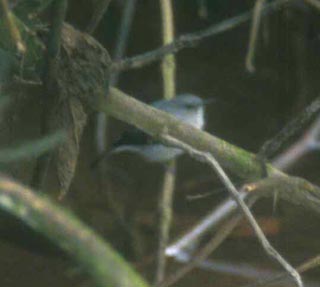 Cassin's
Flycatcher Muscicapa cassini: one perched just over the river, and
below overhanging branches, at “The Neck” in Bwindi-Impenetrable NP (photo
right)
Cassin's
Flycatcher Muscicapa cassini: one perched just over the river, and
below overhanging branches, at “The Neck” in Bwindi-Impenetrable NP (photo
right)
Dusky-blue Flycatcher Muscicapa comitata: single bird both days
at Bigodi Swamp near Kibale Forest, often sitting right on the boardwalk
White-starred Robin Pogonocichla stellata **: Alfred taped this
fine bird in for close, quick views at Ruhiza
Equatorial Akalat Sheppardia aequatorialis: a half-dozen or
so seen inside the forest at Buhoma
White-bellied Robin-Chat Cossyphicula roberti **: one was viewed
through Birdquest’s scope at Buhoma; the one bird we got because we ran
into that tour
Archer's Robin-Chat Cossypha archeri **: Alfred & I worked
on several before finally getting outstanding views at Mubwindi Swamp,
Ruhiza. The latter bird gave a great performance — singing, tail-pumping,
wing-flicking — couldn’t get rid of it! A snazzy rusty bird with long white
supercilium and warbling song. This is an Albertine Rift endemic seen only
at higher elevations
White-browed Robin-Chat Cossypha heuglini: common in QEII park,
including around Mweya Lodge where some fed on the grass in back of our
room
Snowy-crowned Robin-Chat Cossypha niveicapilla **: surprisingly
common as they dashed across roadsides from thicket to thicket in rural
country in the foothills of w. & sw. Uganda
Spotted Morning-Thrush Cichladusa guttata: several skulking
in bushes near the Nile delta at Murchison Falls park
Brown-backed Scrub-Robin Cercotrichas hartlaubi **: singles
at Ruhiza & Kibale Forest, in roadside scrub
African Stonechat Saxicola axillaris: common in open fields
and scrub in sw. Uganda; recent work splits all the resident African races
from Common Stonechat S. torquata
Sooty Chat Myrmecocichla nigra: common in open country in sw.
Uganda, esp. in L. Mburo NP, and around Murchison Falls park & vicinity
Trilling Cisticola Cisticola woosnami **: several were working
the thickets behind our tent in thornscrub at L. Mburo
Chubb's Cisticola Cisticola chubbi: the loud bubbling song was
common in rank vegetation at roadside in Bwindi, and esp. up around Ruhiza
and down in Mubwindi Swamp
Rattling Cisticola Cisticola chiniana: seemed to be the common
cisticola at Murchison Falls park
Winding Cisticola Cisticola galactotes: this colorful cisticola
with rusty wingpatch was found daily at water's edge at L. Mburo, in QEII
and Murchison parks, and at L. Bisina
Carruthers's Cisticola Cisticola carruthersi: common inside
extensive papyrus patches along Kaziranga Channel, QEII park, and at L.
Mburo
Stout Cisticola Cisticola robustus: one at QEII park seemed
to be this species
Croaking Cisticola Cisticola natalensis: a couple at Murchison
Falls park
Foxy Cisticola Cisticola troglodytes **: a nice distinctive
cisticola found in grassy scrub atop the Butiába escarpment, a spot
from which it is well-known
Zitting Cisticola Cisticola juncidis: a few were in patches
of grass at L. Mburo, then it was common in grasslands at QEII and Murchison
parks
Tawny-flanked Prinia Prinia subflava: scattered birds or pairs
found in open scrubland from L. Mburo to Masindi and Entebbe
White-chinned Prinia Prinia leucopogon: pairs seen nicely at
Buhoma, QEII park, and Bigodi Swamp
Banded Prinia Prinia bairdii: secretive in undergrowth but several
seen very well on Mubwindi hike at Ruhiza; heard more elsewhere in Bwindi
Red-winged Gray Warbler Drymocichla incana **: some from the
Dutch/Belgium group and I chased one down in thickets near the top of Murchison
Falls, where it acted like an undergrowth apalis
Collared (Rwenzori) Apalis Apalis ruwenzori **: although reasonably
common in undergrowth on the hike to Mubwindi Swamp at Ruhiza, this was
a real bear to see, skulking and fast-moving. It took numerous tries before
seen decently
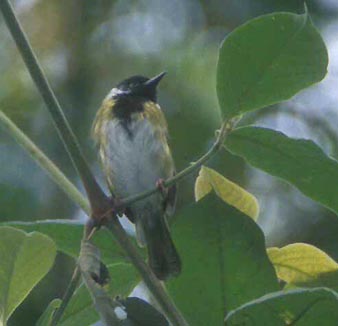 Black-throated
Apalis Apalis jacksoni **: several on the Mubwindi Swamp hike at Ruhiza,
and more in the forest at Buhoma -- another canopy bird, easy to see
Black-throated
Apalis Apalis jacksoni **: several on the Mubwindi Swamp hike at Ruhiza,
and more in the forest at Buhoma -- another canopy bird, easy to see
Black-faced (Montane Masked) Apalis Apalis personata **: in
contrast to A. ruwenzori, this was common and easy to see at Ruhiza,
and one even posed nicely for photos (photo right)
[Yellow-breasted Apalis Apalis flavida: Rita had a couple in
thornscrub east of Masindi; I missed this widespread species there but
have seen many in Kenya & Tanzania]
Buff-throated Apalis Apalis rufogularis: rather common in canopy
flocks at Mabira Forest
Chestnut-throated Apalis Apalis porphyrolaema: "did you leave
this number?" That was our joke every time we heard one, which was rather
commonly in forests at all elevations in Bwindi-Impenetrable. The vocalization
recalls a ringing cell phone
Gray Apalis Apalis cinerea: a couple in canopy flocks at Buhoma
Gray-capped Warbler Eminia lepida: Alfred taped one in for nice
views at Ruhiza; also heard in Kibale Forest. Song recalls Yellow-breasted
Chat but I didn't learn it that well; there were likely more about
Gray-backed Camaroptera Camaroptera brachyura: common in thornscrub,
e.g., L. Mburo, QEII, SE of Masindi
Olive-green Camaroptera Camaroptera chloronota: one watched
as in worked tangles inside the forst at Buhoma
Lesser Swamp-Warbler Acrocephalus gracilirostris **: a couple
were in dense papyrus where the bridge crossed the Kazinga Channel; we
missed Greater Swamp-Warbler A. rufescens (but fortunately I’d see
it before at Kisumu, Kenya)
White-winged Swamp-Warbler Bradypterus carpalis **: this was
a very frustrating bird and took me many efforts to finally see. It skulks
low in papyrus swamps. Although we taped in several birds along the Bigodi
Swamp boardwalk, I saw none of them. We tried Kazinga Channel and various
patches of papyrus on the Kibale Road. I eventually got tape of one, and
we used that snippet at other papyrus swamps along the road north of Fort
Portal until one finally (!!) appeared briefly at my feet for quick views.
This is a papyrus specialist confined to Uganda, Rwanda & ne. Dem.
Rep. of Congo
Grauer's Swamp-Warbler Bradypterus graueri **: three were seen
rather quickly and well in Mubwindi Swamp, Ruhiza; there was one right
as Alfred & I walked up to the swamp's edge, and we didn't need a tape
at all. This is a rare and endangered Albertine Rift endemic
Black-faced Rufous Warbler Bathmocercus rufus: the pulsating,
high-pitched & penetrating song was heard widely daily around Buhoma,
and we saw one of them very well in the undergrowth
Moustached Grass-Warbler Melocichla mentalis **: a singing bird
in scrub at the top of the Butiába escarpment was watched at length,
and was a fine treat
Mountain Yellow Warbler Chloropeta similis: fine views of a
singing bird taped in by Alfred at Mubwindi Swamp, Ruhiza
Green-backed Eremomela Eremomela canescens **: one in thornscrub
east of Masindi
Green-capped Eremomela Eremomela scotops: one was watching singing
in a thicket on the shores of L. Mburo
[Short-tailed (Neumann's) Warbler Hemitesia neumanni: we taped
in two different birds at Buhoma with Rossouw's Uganda tape but, as I was
wearing out-dated contacts at the time, I never got on them quick enough
to get a good view. Rita saw both of them well; it was extremely frustrating
for me (I didn't tic it)]
Green Hylia Hylia prasina: Alfred whistled one in along the
river at Buhoma our first afternoon there (before the downpour), and I
quickly learned the two-note call and found another for Rita the next day
Red-faced Woodland-Warbler Phylloscopus laetus **: common in
Bwindi-Impenetrable park, and esp. at higher elevations around Ruhiza.
This must be the easiest Albertine Rift endemic to see
Scaly-breasted Illadopsis Illadopsis albipectus: heard singing
in Mabira Forest but efforts to lure it in with tapes not successful in
the rain (I had seen this before in Kakamega Forest, Kenya). Pale-breasted
I.
rufipennis was heard by Alfred in Bwindi, but I didn’t get on it
Mountain Illadopsis Illadopsis pyrrhoptera **: one taped in
at Ruhiza was very dark with a gray throat and tawny flanks; it was an
undergrowth skulker
Brown Illadopsis Illadopsis fulvescens: heard singing in Mabira
Forest but efforts to lure it in with tapes not successful in the rain
(we had seen this before in La Lopé Reserve, Gabon)
African Hill-Babbler Pseudoalcippe abyssinica: a few daily in
small mid-level flocks in forest at Ruhiza. The race here (atriceps)
is black-headed and sometimes considered a separate species, but Fry et
al. (2000) state it has the same vocalizations and behavior of other races,
and do not split it
Arrow-marked Babbler Turdoides jardineii: a small flock were
in cultivation outside Buhoma; Rita saw them but I only heard them (more
were seen later in Tanzania)
Black-lored Babbler Turdoides sharpei: small flocks in scrub
at L. Mburo & QEII park
Brown Babbler Turdoides plebejus **: a small noisy flock in
overgrown orchard on the main road between Masindi and Kampala were unexpected
White-shouldered Tit Melaniparus guineensis **: a few were in
open scrubland in Murchison Falls park, and a few more were found the next
day east of Masindi. This pale-eyed taxon is now split from White-winged
Tit M. leucomelas (widespread south & east of Congo Basin) because
the two appear to replace each other altitudinally in Ethiopia (Harrap
& Quinn 1995). This is the bird of open scrubby plains from west Africa
east, south of the Sahara
Dusky Tit Melaniparus funereus: a small party along the roadside
at Ruhiza, another a Buhoma
Stripe-breasted Tit Parus fasciiventer **: a single bird of
this Albertine Rift endemic was in a mixed bird party on the trail from
Mubwindi Swamp, Ruhiza
African Pied Wagtail Motacilla aguimp: very common & widespread
in open country or shores; recorded every day
Cape Wagtail Motacilla capensis: two foraging in cultivated
fields outside Buhoma were the only ones
Yellow-throated Longclaw Macronyx croceus: common at L. Mburo
& QEII parks, and also L. Bisina
Grassland Pipit Anthus cinnamomeus: the widespread pipit of
grasslands, esp. QEII park
Plain-backed Pipit Anthus leucophrys: a handful in L. Mburo
park
African Yellow White-eye Zosterops senegalensis: common in forests
at Bwindi, Kibale, Murchison & Mabira; mostly in canopy flocks
Little Green Sunbird Anthreptes seimundi **: one with a canopy
flock at Mabira Forest
Western Olive-Sunbird Cyanomitra obscura: we saw a few, and
heard many more, zipping around inside the forest at Buhoma, recalling
hermits in Neotropical forests. Also heard at Kibale & Mabira forests
Collared Sunbird Hedydipna collaris: common & widespread
at forest edge, Bwindi & Murchison parks
Bronze Sunbird Nectarinia kilimensis: a pair foraged daily in
the fruiting tree outside our lodge at Buhoma
Green-headed Sunbird Cyanomitra verticalis: a pair, plus an
imm. male, foraged daily in the fruiting tree outside our lodge at Buhoma.
This is a forest-edge sunbird but the head often looks blue, making separation
with Blue-headed Sunbird difficult at times
Blue-headed Sunbird Cyanomitra alinae **: an Albertine Rift
endemic that was seen daily in the forest at Ruhiza. Both its head and
belly are darker shades of blue and gray, respectively, than Green-headed,
and the eye is red
Northern Double-collared Sunbird Cinnyris reichenowi: up to
a dozen each day at Ruhiza, and a few farther downslope in Bwindi. The
field guide has this as Cinnyris preussi, but the specific name
changed when this species was moved out of Nectarina to Cinnyris
(see Vol. VI, Birds of Africa)
Olive-bellied Sunbird Cinnyris chloropygia: a couple daily in
Kibale Forest, and a male in Mabira Forest
Rwenzori Double-collared Sunbird Cinnyris stuhlmanni **: a male
was in a flowering tree at 2100m elevation below Ruhiza, where Alfred identified
it quickly although this was just the 2nd Bwindi-Impenetrable park record.
Its usual range is at higher elevations a bit farther south, as in Mgahinga
NP (where common) — we could see these volcanoes from the site we watched
this bird. After seeing and hearing dozens of N. Double-collared Sunbirds,
this one look bigger and heavier, stouter-billed, and had a rougher “jit”
call. I wrote full field notes that night since it was a rarity. Alfred
later showed what was presumable the same bird to the Birdquest tour 3
days later, and their leader Nik Borrow video-taped it. Nik is not yet
convinced of the i.d. because the callnote does not seem to match the vocalization
on the Chappuis tape set. He continues to research this issue. While I
have no experience with this problem, the bird in question sounded different
in callnote quality than the many N. Double-collareds heard those two days
at Ruhiza. The bird to me seemed bigger and heavier-billed than N. Double-collared,
as perhaps can be seen in my poor photo (above
left) and Nik Borrow's much better video snap of his bird three
days later (above right; © Nik Borrow, all
rights reserved)
Regal Sunbird Cinnyris regia **: this gorgeous Albertine Rift
endemic was inside the forest at Ruhiza; three males were seen on my Mubwindi
Swamp hike
Mariqua Sunbird Cinnyris mariquensis: a male in flowers enroute
to L. Mburo
Purple-banded Sunbird Cinnyris bifasciata **: an imm. male viewed
& photographed at close range in thornscrub at L. Mburo park
Scarlet-chested Sunbird Chalcomitra senegalensis: common in
Mabira Forest; also at Entebbe
Beautiful Sunbird Cinnyris pulchella: a nice male in Murchison
Falls NP
Red-chested Sunbird Cinnyris erythroceria: very common at QEII,
including around Mweya Lodge, and more at L. Victoria edge at Entebbe
Yellow-billed Oxpecker Buphagus africanus: a fair number daily
were seen on buffalo, giraffe, and other large mammals in QEII and Murchison
Falls parks
[Stuhlmann's Starling Poeoptera stuhlmanni: Rita had a flock
of 10 at Ruhiza while I was on the Mubwindi Swamp hike.]
Narrow-tailed Starling Poeoptera lugubris **: one seen in flight
on my Mubwindi Swamp hike, Ruhiza
Waller's Starling Onychognathus walleri **: at least two, maybe
more, at Ruhiza
Slender-billed Starling Onychognathus tenuirostris: big flock
of 40+ perched in a dead tree in early morning at Ruhiza
Splendid Glossy-Starling Lamprotornis splendidus: large flocks
daily around Kibale Forest, including many fly-catching near dusk at Bigodi
Swamp, and more in Mabira Forest
Greater Blue-eared Glossy-Starling Lamprotornis chalybaeus:
a flock of 15 was gorging in a fruiting tree on the shore of Lake Mburo;
we surprisingly saw no others
Rüppell's Long-tailed Starling Lamprotornis purpuropterus:
the abundant starling of open country; 30-100+ daily whenever in habitat
Purple-headed Glossy-Starling Lamprotornis purpureiceps: small
flocks daily at Bigodi Swamp, Kibale
[Sharpe’s Starling Pholia sharpii: Rita had a pair with the
Stuhlman’s at Ruhiza while I was hiking to Mubwindi Swamp; this would have
been a lifer for me.]
Amethyst (Violet-backed) Starling Cinnyricinclus leucogaster:
a dozen or so in plains N of Nile at Murchison Falls park
Wattled Starling Creatophora cinerea: widespread and common
in QEII park, but only 1 seen at Murchison
Northern Gray-headed Sparrow Passer griseus: common around rural towns
and in scrub at Murchison & QEII parks
Speckle-fronted Weaver Sporopipes frontalis: a few were working
in one nest shrub at Murchison Falls NP
Chestnut-crowned Sparrow-Weaver Plocepasser superciliosus **:
this is a speciality of the north; we saw one atop Butiába Escarpment
and 3 more N of the Nile in Murchison Falls NP. This weaver really reminds
me of the w. North American Lark Sparrow
Baglafecht Weaver Ploceus baglafecht: small flocks common in
cultivation around Buhoma town, and Kampala vicinity, with scattered individuals
in open country elsewhere
Slender-billed Weaver Ploceus pelzelni: very common at resorts
near marshedge, such as Mweya Lodge, QEII park, where they haunt the dining
room, stealing what they can. Also Entebbe and Murchison.
Little Weaver Ploceus luteolus **: small flock intermixed with
Slender-billed Weavers at Entebbe, near the shore of L. Victoria
Lesser Masked Weaver Ploceus intermedius: a pair of pale-eyed
weaver seen from our boat on the Nile were apparently this species, although
some points (seemingly whitish belly on female) suggested Heuglin’s Masked
P.
heuglini from the field guide depiction. Rossouw & Sacchi (1998)
do not list Heuglin’s from the Murchison Falls vicinity, so presumably
our initial impressions were erroneous and we floated on by...
Black-necked Weaver Ploceus nigricollis: a pair daily around
our lodge at Buhoma, another pair nest-building at Kibale Forest edge,
and a pair in Mabira Forest
Black-billed Weaver Ploceus melanogaster: Male working on nest
inside forest at Buhoma
Strange Weaver Ploceus alienus **: perhaps the bird I enjoyed
most on the hike to Mubwindi Swamp, Ruhiza, was this strange weaver indeed.
It was skulking in the undergrowth with a flock, acting for all the world
like an elusive Bradypterus or scrub-robin
Holub's Golden Weaver Ploceus xanthops: small flocks in cultivation
at Buhoma town, and a nest-building bird enroute to Murchison park
Northern Brown-throated Weaver Ploceus castanops **: small flock
in papyrus at L. Mburo, and five (3 male, 2 female) in a colony on L.
Bisina [which we were told at the time were "Fox's Weaver." See
discussion below and on the Daily Log page].
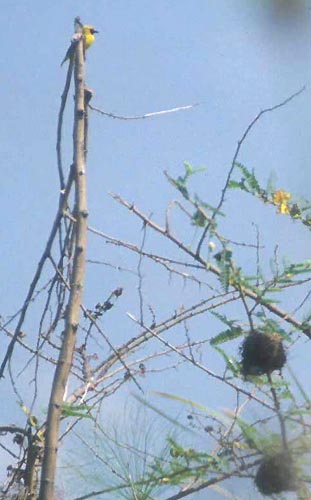 [Fox's
Weaver Ploceus spekeoides: not seen although we thought we had seen it at the time and published this photo (right — not Fox's Weaver but, instead, Northern Brown-throated Weaver).
In 2011, Nik Borrow advised this photo is of Northern Brown-throated
Weaver, a common breeder at aquatic colonies on Lake Bisina. There is
no reason to believe Fox's is an aquatic breeder, says Nik.]
[Fox's
Weaver Ploceus spekeoides: not seen although we thought we had seen it at the time and published this photo (right — not Fox's Weaver but, instead, Northern Brown-throated Weaver).
In 2011, Nik Borrow advised this photo is of Northern Brown-throated
Weaver, a common breeder at aquatic colonies on Lake Bisina. There is
no reason to believe Fox's is an aquatic breeder, says Nik.]
Village Weaver Ploceus cucullatus: common in the countryside
around Entebbe, and some in Murchison Falls vicinity, but not as widespread
as I had expected
Vieillot's Black Weaver Ploceus nigerrimus: a nesting colony
at headquarters of Kibale Forest was fun to watch; more colonies scattered
in the Murchison vicinity
Yellow-backed Weaver Ploceus melanocephalus: common at Mweya
Lodge, QEII park; also Murchison park
Yellow-mantled Weaver Ploceus tricolor: one in Mabira Forest
Brown-capped Weaver Ploceus insignis: this nuthatch-mimic was
found in small numbers at both Ruhiza and Buhoma
Compact Weaver Pachyphantes superciliosus **: I got to see one
non-breeding-plumaged bird in cultivated fields outside the little town
of Buhoma; this is really right across the road from Alfred’s house here.
We had seen the used nest (very impressive -- sits up by itself on a forked
bare stick) the day before, but it took Alfred the next morning to see
an actual bird. This is very much a local species, and I’ve wanted to see
it ever since Jon Hornbuckle emphasized it in his 2001 Uganda report
Red-headed Malimbe Malimbus rubricollis: a pair working like
nuthatches on a mossy tree-trunk at Bigodi Forest, near Kibale
Cardinal Quelea Quelea cardinalis **: one female in grasslands
at QEII; small flock at Murchison park
Red-headed Quelea Quelea erythrops **: one female at Bigodi
Swamp, small flock in grasslands of Murchison park
Red-billed Quelea Quelea quelea: common in both QEII and Murchison
Falls parks
Grosbeak Weaver Amblyospiza albifrons: an odd call-note attracted
Hassan’s attention at Bigodi Forest; it proved to be a begging juv. of
this species
Black-winged Bishop Euplectes hordeaceus **: common in grasslands
at Murchison Falls park; scattered birds elsewhere, including Kaaku Swamp
and QEII park
Southern Red Bishop Euplectes orix; one male at QEII park
Northern Red (Orange) Bishop Euplectes franciscanus: common
in grasslands at Murchison Falls park. The males here are very red, so
"Orange Bishop" is a poor English name
Yellow Bishop Euplectes capensis: molting birds, mostly pairs,
in open country near Ruhiza and Buhoma town
Fan-tailed Widowbird Euplectes axillaris: common at Murchison
Falls park at swamp edge
Yellow-mantled Widowbird Euplectes macrourus: male and a few
females in Murchison Falls grasslands
Gray-headed Negrofinch Nigrita canicapilla: one seen at Buhoma,
three more in Bigodi Swamp; also Mabira Forest
White-breasted Negrofinch Nigrita fusconota: small party of
4 inside Mabira Forest
White-collared Olive-back Nesocharis ansorgei **: another significant
highlight for me was actually laying eyes on these secretive seedeaters.
A small flock was working the papyrus along the boardwalk at Bigodi Swamp,
giving very soft, high-pitched calls, and took quite some time to see properly
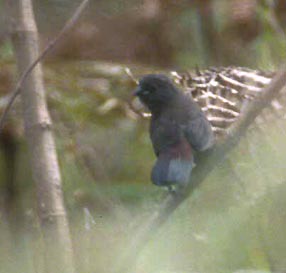 Dusky
Twinspot Mandingoa nitidula **: after quite an effort, Alfred found
a family with two juvs foraging in ferns and weeds below Ruhiza (photo
right). Missed all the crimsonwings, though....
Dusky
Twinspot Mandingoa nitidula **: after quite an effort, Alfred found
a family with two juvs foraging in ferns and weeds below Ruhiza (photo
right). Missed all the crimsonwings, though....
[Red-headed Bluebill Spermophaga ruficapilla: I was busy photographing
a mousebird when this bird appeared at forest-edge at Buhoma. Only Rita
& Alfred saw it, but I have seen others in Kakamega Forest, Kenya]
Red-cheeked Cordonbleu Uraeginthus bengalus: small flocks were
common in Murchison Falls park
Red-billed Firefinch Lagonosticta senegala: flocks were very
common at QEII park, and a few elsewhere
Common Waxbill Estrilda astrild: common at papyrus edge in L.
Mburo park, but that was it
African Firefinch Lagonosticta rubricata **: one female in open
country below Ruhiza; surprising I’d never seen one on any prior African
trips [it would become reasonably common in n. Tanzania]
Black-crowned Waxbill Estrilda nonnula: small groups daily in
Kibale Forest vicinity
[Black-headed Waxbill Estrilda atricapilla: Rita had a small
group at Buhoma village while I was searching for Compact Weaver; I'd seen
it elsewhere before]
Black-rumped Waxbill Estrilda troglodytes **: a couple were
sneaking through the reeds on an island in L. Bisina; I pished them up
for quick views
Zebra Waxbill Amandava subflava **: most unexpected was a pair
of this lovely finch in an overgrown orchard among thorn-scrub SE of Masindi.
They were very secretive and hard to view, but very cool...
Bronze Munia Lonchura cucullata: common and widespread in open
country, L. Victoria to Murchison
Black-and-white Munia Lonchura bicolor: group of 3 in Bigodi
Swamp
Magpie Manakin Lonchura fringilloides **: Rita found one nest-building
on a big tree-limb right in front of our lodging at Buhoma, Bwindi
Pin-tailed Whydah Vidua macroura: a pair in full plumage at
QEII park, and then common around the Murchison vicinity
Village Indigobird Vidua chalybeata: I got a view of one from
the vehicle near Murchison Falls; Hassan had another or two, but we never
got one perched and in the bins for Rita
Brimstone Canary Serinus sulphuratus: one male perched at roadside
outside Buhoma
Yellow-fronted Canary Serinus mozambicus: pairs daily in QEII
park, and more enroute to Murchison
Cape Canary Serinus canicollis: a pair was eating minerals out
of a small cave in a road cut below Ruhiza
Thick-billed Seedeater Serinus burtoni: one or two daily at
Ruhiza
Streaky Seedeater Serinus striolatus: common around Buhoma,
Bwindi
Cinnamon-breasted Bunting Emberiza tahapisi **: a male in scrub
atop the Butiába Escarpment
African Golden-breasted Bunting Emberiza flaviventris: a couple
males along roadsides in the Rwenzori foothills
A comment on some species missed:
during our rather short trip, we felt we did reasonably well on the specialty
birds we had especially hoped to find. We made extensive efforts for both
African Green (Grauer's) Broadbill Pseudocalyptomena graueri and
Green-breasted Pitta Pitta reichenowi, but just missed these rare
species, possibly hurt by the extremely dry season this July. We also missed Fox's Weaver (see above). Between us
we saw 16 of 24 possible Albertine Rift endemics, but missed a few I thought
we would find (e.g., Grauer's Warbler Graueria vittata). Our unfamiliarity
with local vocalizations also cost species — we found no crombecs or longbills
at all. Being with a tour would have added many birds. But we both found
it a lot more fun finding our own birds, for the most part.
MAMMALS
The taxonomic order follows Macdonald (1985); identification is from
Kingdom (1997).
Lion Panthera leo: a lioness with 2 cubs at a kill in grasslands
of QEII park, and another male and female seen across the river from Mweya
Lodge, plus another lioness in grasslands N of Nile in Murchison Falls
NP
African Clawless Otter Aonyx capensis: a large otter that crossed
the road in front of us near Kibale Forest; it was moving from one swampy
stretch to another
African Civet Civettictis civetta: during a morning drizzle
at Mabira Forest, one calmly walked down the dirt road toward us before
turning into the forest; it was exceptional to see this nocturnal and shy
species during the day
Large-spotted Genet Genetta tigrina: one just after dawn during
a game drive in thornscrub at QEII park
Banded Mongoose Mungos mungo: small bands daily in L. Mburo,
QEII, and Murchison parks. Those at Myewa Lodge were exceptionally entertaining,
grooming complacent warthogs and, eventually, me....
White-tailed Mongoose Ichneumia albicauda: one after dark near
the ferry in Murchison Falls park
Spotted Hyena Crocuta crocuta: we had a female with 3 cubs sleeping
at mid-day under a bush in QEII park, plus two more elsewhere in that park,
but the most fun was while we were out walking with a guard in L. Mburo
park, a large adult hyena came out of the brush to lake's edge near us
— and was shocked to see us out in the open, scurrying off in a hurry
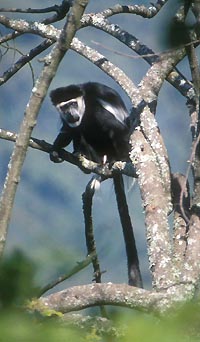 Gray-cheeked
Mangaby Cercocebus albigena: good numbers in Kibale Forest, some of
them gorging on fruit
Gray-cheeked
Mangaby Cercocebus albigena: good numbers in Kibale Forest, some of
them gorging on fruit
Vervet Monkey Cercopithecus aethiops: common in L. Mburo, QEII,
and Murchison Falls parks
Red-tailed Monkey Cercopithecus ascanius: a few with Mangabys
in Kibale Forest, and more at Mabira Forest
L'Hoest's Monkey Cercopithecus lhoesti: small numbers seen each
day in the forest at Ruhiza, and one in Kibale Forest
Blue (Sykes') Monkey Cercopithecus mitis: one each day up at
Ruhiza
Savanna Baboon Papio cynocephalus: a band of 'Olive Baboon'
(race anubis) was in Lake Mburo park, and many more were seen daily
around Kibale Forest and Murchison Falls NP
Black-and-white Colobus Colobus angolensis: we had fine views
of troops in treetops at Ruhiza (photo right),
Bigodi Swamp, Kibale Forest, and Murchison Falls NP
Pennant's Red Colobus Colobus pennantii: a troop of perhaps
40 monkeys were intermixed with Black-and-white Colobus at Bigodi Swamp
Mountain Gorilla Gorilla gorilla berengei: a major highlight
of the entire trip was the hour spent watching the antics of a family group
above Buhoma; more details in the daily
log and (eventually) on a separate Gorilla page
Chimpanzee Pan troglodytes: another incredible experience with
a family group in Kibale Forest; more details in the daily
log and (eventually) on a separate Chimpanzee page
Savanna Elephant Loxodonta africana: we saw three in Murchison
Falls NP, including one along the Nile during our ride to the Falls themselves;
it seems that the numbers of elephants have not rebounded entirely from
Uganda's past
Comon Zebra Equus burchelli: the only park in which they occur
in Uganda is L. Mburo NP, and here they are common
Giant Forest Hog Hylochoerus meinertzhageni: small party of
varying ages approached closely in QEII park
Warthog Phacochoexus aethiopicus: very common in thornscrub
habitat in parks — L. Mburo, QEII, and Murchison. They were very tame and
grazed lawns in front and back of rooms at Mweya Lodge
Hippopotamus Hippopotamus amphibius: very common in lakes and
rivers of L. Mburo, QEII and Murchison parks.
Giraffe Giraffa camelopardalis: numbers are still low — we saw
only a couple dozen at Murchison Falls NP
Bushbuck Tragelaphus scriptus: a few (1-3/day) in thornscrub
at L. Mburo, QEII, and Murchison parks
Eland Taurotragus oryx: a herd of 25 or so at Lake Mburo park
was very skittish
African Buffalo Synceros caffer: only a few at L. Mburo but
very common in large herds at QEII and Murchison parks
Defassa Waterbuck Kobus defassa: very common in L. Mburo, QEII,
and Murchison Falls parks
Kongoni Alcelaphus buselaphus cokii: scattered small herds in
L. Mburo and QEII parks
Oribi Ourebia ourebi: a half-dozen scattered about in thornscrub
inside and outside L. Mburo park
Uganda Kob Kobus kobi: fair numbers in QEII park but many more
in herds in grasslands at Murchison Falls park
Impala Aepyceros melampus: the only park in which they occur
in Uganda is L. Mburo NP, and here they are very common
Carruther's Mountain Squirrel Funisciurus carruthersi: fairly
common in highland forest at Ruhiza
Boehm's Squirrel Paraxerus boehmi: a few each day around Kibale
Forest
Alexander's Squirrel Paraxerus alexandri: one in Mabira Forest
was identified for us by Ibraham
Rwenzori Sun Squirrel Heliosciurus ruwenzori: two seen in the
forest enroute to Mubwindi Swamp, Ruhiza
Four-striped Grass-Mouse Phabdomys pumilio: one in grasslands
at QEII park seemed to match this species in the guide
Hare, sp.?: one at Murchison Falls NP was either Cape Hare Lepus
capensis or Scrub Hare L. saxatilis
Fruit-Bat, sp?: hundreds were roosting in the palms, and nosily
flying about all night, at the hotel in Jinja. Possibly Wahlberg's Epauletted
Fruit-Bat Epomophorus wahlbergi but I'm not sure
Yellow-winged Bat Lavia frons: it was really fun watching these
quasi-diurnal bats hunt. They hang upside down in a bush, looking around
and waving their long ears, and they sally out for insects, just like a
flycatcher. They return to the same perch — just like a flycatcher — but
then land and flip upside down to regain their hanging position. Fair numbers
were seen daily in QEII park
We also had a variety of unidentified small bats in various parks.
HERPS (Amphibians & Reptiles)
Nile Crocodile Crocodylis niloticus: common along the Nile in
Murchison Falls park, and others in Lake Mburo
Nile Monitor Varanus niloticus: one at the Nile delta in Murchison
Falls NP
Blue-headed Tree Agama Acanthocerus atricollis: the colorful
blue-headed agamas at Ruhiza and QEII park were apparently this species,
per Spawls et al. (2002)
Rainbow (Red-headed Rock) Agama Agama agama: these colorful
lizards sunned on the porticals of Paara Lodges, Murchison Falls NP
Despite having the new guide book (Spawls et al. 2002), we saw a number
of unidentified geckos, skinks, and turtles. We really didn't get decent
views of any of them
PHOTOS: All photos on this page are © 2002 Don Roberson
except as otherwise noted; all rights reserved.
Literature cited:
Fry, C. H., S. Keith, and E. K. Urban. 1988. The Birds of Africa.
Vol. 3. Academic Press, London.
Harrap,S., and D. Quinn. 1995. Chickadees, Tits, Nuthatches and Treecreepers.
Princeton Univ. Press, Princeton, N.J.
Holyoak, D.T. 2001. Nightjars and their Allies. Bird Families of the
World, No. 7. Oxford Univ. Press, Oxford, U.K.
Kingdon, J. 1997. The Kingdon Guide to African Mammals. Academic Press,
London.
Macdonald, D., ed. 1985. The Encyclopedia of Mammals, 1st ed. Facts
on File, New York.
Rossouw, J. and M. Sacchi. 1998. Where to Watch Birds in Uganda. Uganda
Tourist Board, Kampala.
Spawls, S., K. Howell, R. Drewes, and J. Ashe. 2002. A Field Guide to
the Reptiles of East Africa. Academic Press, London.
Stevenson, T., and J. Fanshawe. 2002. Field Guide to the Birds of East
Africa. T & AD Poyser, London.
Urban, E. K., C. H. Fry, and S. Keith. 1997. The Birds of Africa. Vol.
5. Academic Press, London.
TOP
GO TO
UGANDA TRIP 2002 SUMMARY
GO TO LIST OF BIRD
FAMILIES OF THE WORLD
GO TO TRIPS PORTAL
PAGE
GO TO MONTEREY COUNTY
PAGE
GO TO HOME PAGE
Page created 2 Sep-6 Oct 2002, slightly updated 10 Sep 2011
 Pink-backed
Pelican Pelecanus rufescens: recorded widely; good numbers at Murchison
and along Lake Victoria
Pink-backed
Pelican Pelecanus rufescens: recorded widely; good numbers at Murchison
and along Lake Victoria
 Dark
Chanting-Goshawk Melierax metabates: a couple hunting the open plains
N of the Nile at Murchison
Dark
Chanting-Goshawk Melierax metabates: a couple hunting the open plains
N of the Nile at Murchison

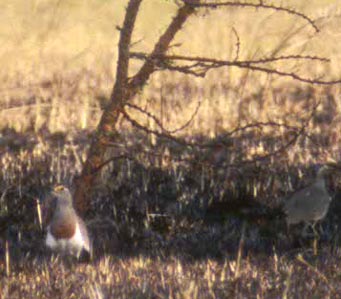
 Pel's
Fishing-Owl Scotopelia peli **: another major highlight for me was
seeing this often-sought fish owl. Hassan knew woods below Murchison Falls
where day roosts are sometimes found. Our boat trip up the Albert Nile
to the falls landed us on a steep trail to the top of the falls. If one
went the other way -- steeply down into a riverine canyon, one got to the
possible roost spot. Rita waited behind while the British group and I followed
Hassan down into those woods and, remarkably, Hassan found a roosting owl.
Alas, it flushed rather rapidly -- before everyone got on it -- but I did
manage to get one photo off (photo right)
Pel's
Fishing-Owl Scotopelia peli **: another major highlight for me was
seeing this often-sought fish owl. Hassan knew woods below Murchison Falls
where day roosts are sometimes found. Our boat trip up the Albert Nile
to the falls landed us on a steep trail to the top of the falls. If one
went the other way -- steeply down into a riverine canyon, one got to the
possible roost spot. Rita waited behind while the British group and I followed
Hassan down into those woods and, remarkably, Hassan found a roosting owl.
Alas, it flushed rather rapidly -- before everyone got on it -- but I did
manage to get one photo off (photo right)
 Shining
Blue Kingfisher Alcedo quadribrachys: Alfred spotted one just over
the small stream on our first afternoon at Buhoma; it flew deep into the
tangles but (amazingly) I was able to shoot a photo (photo
right) by lying on the ground, using a log as a tripod, and
shooting 400 speed film at 1/8 second! This was an unexpected treat since
it is a shy and elusive species
Shining
Blue Kingfisher Alcedo quadribrachys: Alfred spotted one just over
the small stream on our first afternoon at Buhoma; it flew deep into the
tangles but (amazingly) I was able to shoot a photo (photo
right) by lying on the ground, using a log as a tripod, and
shooting 400 speed film at 1/8 second! This was an unexpected treat since
it is a shy and elusive species
 African
Hoopoe Upupa africana: just one or two seen from the moving vehicle
in Murchison park
African
Hoopoe Upupa africana: just one or two seen from the moving vehicle
in Murchison park
 Brubru
Nilaus afer: one is scrub east of Masindi, with a foraging flock
Brubru
Nilaus afer: one is scrub east of Masindi, with a foraging flock
 Rufous-bellied
(Black-headed) Paradise-Flycatcher Terpsiphone rufiventer **: a pair
was photographed nest-building at the Kibale Forest headquarters (photo
right) ; another was in Mabira Forest
Rufous-bellied
(Black-headed) Paradise-Flycatcher Terpsiphone rufiventer **: a pair
was photographed nest-building at the Kibale Forest headquarters (photo
right) ; another was in Mabira Forest
 Cassin's
Flycatcher Muscicapa cassini: one perched just over the river, and
below overhanging branches, at “The Neck” in Bwindi-Impenetrable NP (photo
right)
Cassin's
Flycatcher Muscicapa cassini: one perched just over the river, and
below overhanging branches, at “The Neck” in Bwindi-Impenetrable NP (photo
right)
 Black-throated
Apalis Apalis jacksoni **: several on the Mubwindi Swamp hike at Ruhiza,
and more in the forest at Buhoma -- another canopy bird, easy to see
Black-throated
Apalis Apalis jacksoni **: several on the Mubwindi Swamp hike at Ruhiza,
and more in the forest at Buhoma -- another canopy bird, easy to see
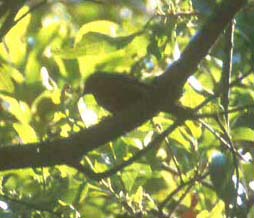
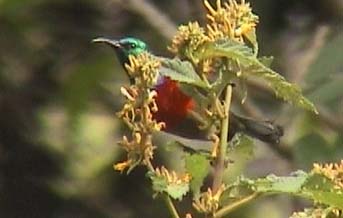
 [Fox's
Weaver Ploceus spekeoides: not seen although we thought we had seen it at the time and published this photo (right — not Fox's Weaver but, instead, Northern Brown-throated Weaver).
In 2011, Nik Borrow advised this photo is of Northern Brown-throated
Weaver, a common breeder at aquatic colonies on Lake Bisina. There is
no reason to believe Fox's is an aquatic breeder, says Nik.]
[Fox's
Weaver Ploceus spekeoides: not seen although we thought we had seen it at the time and published this photo (right — not Fox's Weaver but, instead, Northern Brown-throated Weaver).
In 2011, Nik Borrow advised this photo is of Northern Brown-throated
Weaver, a common breeder at aquatic colonies on Lake Bisina. There is
no reason to believe Fox's is an aquatic breeder, says Nik.]
 Dusky
Twinspot Mandingoa nitidula **: after quite an effort, Alfred found
a family with two juvs foraging in ferns and weeds below Ruhiza (photo
right). Missed all the crimsonwings, though....
Dusky
Twinspot Mandingoa nitidula **: after quite an effort, Alfred found
a family with two juvs foraging in ferns and weeds below Ruhiza (photo
right). Missed all the crimsonwings, though....
 Gray-cheeked
Mangaby Cercocebus albigena: good numbers in Kibale Forest, some of
them gorging on fruit
Gray-cheeked
Mangaby Cercocebus albigena: good numbers in Kibale Forest, some of
them gorging on fruit